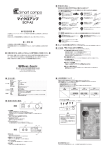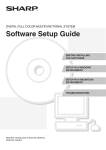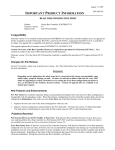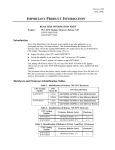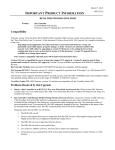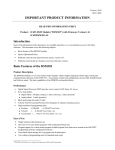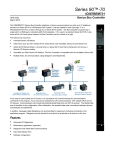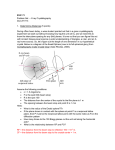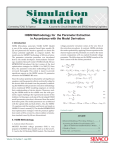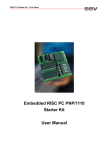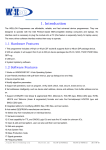Download Bus Controller, IC697BEM731Z, IC687BEM734Z, IC687BEM731
Transcript
March 15, 2010 IMPORTANT PRODUCT INFORMATION GFK-0363AJ READ THIS INFORMATION FIRST Product: Firmware version: Hardware ID: Genius Bus Controller, IC697BEM731Z, IC697BEM734Z, IC687BEM731-AB 6.0 44A729723-G01R06 44A752634-G01R01 Compatibility Firmware Version 6.0 is available in production IC697BEM731Z, IC697BEM734Z, and IC687BEM731-AB modules and as an upgrade kit for Bus Controllers in both PACSystems RX7i PLCs and Series 90-70 PLCs. Upgrade Kit 44A286373G20 is available at no charge upon request. The upgrade kit is compatible with hardware originally produced as IC697BEM731B, IC697BEM734B, or IC687BEM731-AA and later. Version 5.9 or later of the Bus Controller firmware is required for operation in PACSystems RX7i PLCs. Version 5.8 is capable of operation in RX7i PLCs but is subject to a safety issue corrected in version 5.9. Version 5.8 or later of the Bus Controller firmware supports PACSystems RX7i user bulk (%W) memory for GBC COMMREQ status and read-data locations. The specified start address must be in the range %W00001 - %W65535, inclusive. Firmware version 6.0 for the Series 90-70 Genius Bus Controller is qualified for operation in TUV-approved Series 90-70 PLCs. Changes for this Release Version 6.0 corrects a point fault reporting issue in all previous versions. See the Problems Resolved section for more information. Problems Resolved for Release 6.0 Point Fault reporting with rack-based I/O Stations: With release 6.0 firmware, extra fault contacts will not be set when a module installed in a rack based I/O station is lost. This occurred with earlier firmware if the module that was lost had at least 16 points of input or output data and the system was configured for point fault reporting. Operating Notes Power Cycle Of PLC Main and Expansion Racks. If a Genius Bus Controller is installed in an expansion rack and the main rack is power-cycled during the joint CPU-GBC interface tests, the Bus Controller in the expansion rack can be lost when the CPU is next powered on. In an RX7i system, the CPU automatically restores the Bus Controller. In a Series 90-70 PLC system, loss of the Bus Controller can usually be prevented by connecting the main and expansion racks to the same power source and powering them off and on together. Must set Error Rate configuration parameter to zero when using Genius redundancy. The behavior of the GBC during Excessive Bus Faults conditions is not compatible with any of its redundancy modes. If you are using Genius Redundancy, set the Error Rate configuration parameter to 0. As of version 5.9 of the GBC firmware, if the GBC’s hardware configuration has a non-zero Error Rate and contains a device with the Redundancy parameter set to Yes, the GBC replaces the Error Rate value in the stored configuration with 0 and reports a System configuration mismatch fault to the PLC fault table. The error code for this fault is 77 (4D hexadecimal). The fault action is set to Informational so that it will not cause the PLC to go to Stop/Fault mode. BSMs and Error Rate Configuration: If the Genius bus includes any Bus Switching Modules, the Bus Controller’s Error Rate configuration parameter must be set to 0. This keeps the Bus Controller from dropping off the bus while the BSMs are switching. Backplane Communications Window Time For Internally-Redundant Bus Controllers. Operation of internallyredundant Bus Controllers in the same PLC relies on backplane communications between the Bus Controllers. When a PLC hardware configuration includes one or more pairs of internally-redundant Bus Controllers, do not set the Backplane (or System) Communications Window Timer to 0. When the CPU is configured for constant sweep mode, the specified sweep 2 Important Product Information GFK-0363AJ time must be long enough to assure that communications between the Bus Controllers will occur without delays. Depending on the CPU model, communication times from one to six milliseconds are recommended. Impact on PLC Sweep Time when Adding or Losing Bus Devices: If a number of bus devices are lost or added at the same time, the rush of Loss or Addition of Device faults could cause the PLC’s watchdog timer to expire, which will shut down the PLC. For example, I/O blocks that do not use the same power source as the PLC might all lose power during the same CPU sweep, while the CPU does not lose power. Also, when power is restored, the blocks might all return to the system during the same CPU sweep. To avoid the problem, set the PLC’s watchdog timer to a value that accounts for the extra time needed to process the faults. When determining the PLC’s watchdog timer, include the following steps: 1. Determine the maximum number of devices on all busses in the system that might be lost or added in the same PLC sweep period. 2. Find the “Asynchronous Events Fault Message” time listed for the type of CPU in the system. Multiply this time by the number of devices determined in the previous step. 3. Add the total from the previous step to the worst case PLC sweep time. Set the PLC’s watchdog timer to a time that is larger than this value. Storing Hardware Configuration while a Genius Bus Controller has a Serial Bus Address conflict (which is indicated by flashing LEDs) may cause that Bus Controller to fail (Loss of IOC). In addition to the Loss of IOC fault, an IOC Hardware Fault with the value 9F (hexadecimal) in the first byte of the Fault Extra Data may appear. To recover from this error, correct the Serial Bus Address conflict, then cycle power on the rack that contains the Bus Controller. Checking COMMREQ Status for Send Datagrams: When issuing Send Datagram commands (COMMREQ 14), use permissive logic to test the status of the previous COMMREQ and confirm that it completed before issuing the next COMMREQ. Without this synchronization, the Bus Controller may fail (Loss of IOC). Alternatively, COMMREQ 12 (Write Device) can be used instead of COMMREQ 14. I/O Bus Faults for High Genius Bus Scan Times: When the Genius Bus Scan Time is about 220ms or higher, the Genius Bus Controller may periodically generate an I/O Bus Fault with the value 81 (hexadecimal) in the first byte of the Fault Extra Data. For example: For some of these cases, the Bus Controller’s Channel 1 OK LED turns off and remains off. These particular faults and the corresponding change to the Channel 1 OK LED can be safely ignored. Excessive Bus Faults condition coincident with an outstanding COMMREQ: If the Genius Bus Controller declares an Excessive Bus Faults condition while it is waiting for a device to reply to a datagram that was initiated by a COMMREQ, the Bus Controller can either fail (Loss of IOC) or stop processing COMMREQs. When this error causes the Bus Controller to stop processing COMMREQs, the Bus Controller sets the status word for the outstanding COMMREQ to 32 (“Command terminated due to suspected activity on bus”). Then for all subsequent COMMREQs received, even those initiated after the Bus Controller cancels the Excessive Bus Faults condition, the Bus Controller sets the status word to 1 (“Command not accepted – Bus Controller busy with previous request”). To recover from this error, cycle power on the rack that contains the Bus Controller. This error can be prevented by setting the Bus Controller’s Error Rate configuration parameter to 0. I/O fault contacts are cleared for a device that is re-aquired after repair of a broken Genius bus. This is only an issue for PLCs that have point faults enabled. If the Genius bus connection between the GBC and a Genius device is broken, the I/O point fault contacts associated with the device are unconditionally cleared when the bus connection is restored. If that Genius device has an unresolved fault, the I/O fault contacts will not be automatically set back to the faulted state. To compensate for this issue, you should either clear the controller’s I/O fault table or cycle power on the device immediately after repairing the bus. Clearing the I/O fault table will cause all of the Genius devices to re-report their unresolved faults, and will cause the associated I/O point fault contacts to reflect their current status. Important Product Information 3 GFK-0363AJ I/O fault contacts are cleared during power cycle and stores of Hardware Configuration and remain clear until the PLC’s outputs are enabled. This is only an issue for PLCs that have point faults enabled and run with outputs disabled. The GBC unconditionally clears all of its I/O fault contacts when it receives its hardware configuration from the PLC. This occurs whenever the GBC’s power is cycled and also whenever the Hardware Configuration is downloaded. If a Genius device has an unresolved fault, the fault will not appear and the I/O fault contacts will not be set back to the faulted state until the PLC’s outputs are enabled. If this is an issue for your application, you can force the PLC to update the fault contacts by clearing its I/O fault table. Clearing the I/O fault table will cause the Genius fault(s) to be reported and will also cause the associated I/O point fault contacts to be set to the faulted state. Extra Device fault sometimes not logged and consequently Fault Locating References remain set. This phenomenom does not occur when all Genius bus devices are properly configured in the GBC’s hardware configuration. When a Genius Bus Controller is configured for Redundant Controller / Internal Pairs, and a device on its Genius bus is NOT in the hardware configuration, an Extra Device fault is logged in the I/O fault table when the Bus Controller’s rack is powered on and also when the Hardware Configuration is stored. If the extra device is powered off, a Loss of Device fault is logged, and the corresponding fault locating reference points are set to the faulted state. However, if the extra device is then powered on, the expected Extra Device fault does NOTappear, and the corresponding fault locating references remain set to the faulted state. Read/Write Device Rejection: This Bus Controller will ignore any incoming Read or Write Device datagrams sent using the routing parameter FE (hexadecimal) in byte 0. This byte is designated as “reserved” in the datagram descriptions in the Genius I/O System User’s Manual. Document Updates ▪ Description: In some versions of the Bus Controller User’s Manual, there are mistakes in the programming example that illustrates the use of COMMREQs. The Status Pointer Offset given in the example would cause the Status Block to overlap the start of the Command Block. Recommendation: If necessary, correct the Status Pointer Offset example in your manual. In two logic illustrations, and in the table showing the Command Block contents, change the value in %R0103 to 97. The two-word Status Block would then use %R0098 and %R0099, avoiding conflict with the Command Block which begins at %R0100. ▪ Description: Genius Bus Controller User’s Manual GFK-2017 will be updated to describe the following. When the Bus Controller’s Error Rate configuration parameter is set to a non-zero value, disruptions on the Genius bus can cause the Bus Controller to declare an Excessive Bus Faults condition and behave as described below. These behaviors do not occur when the Bus Controller’s Error Rate configuration parameter is set to zero. For Bus Controllers with firmware version 5.9 or later: 1. The Bus Controller turns off its Channel 1 OK LED. 2. The Bus Controller stops sending outputs. Output devices that are configured to default their outputs do so. 3. The Bus Controller stops sending and receiving Genius global data. 4. The Bus Controller logs an “Excessive Bus Faults - High Error Rate” message in the PLC’s I/O fault table. 5. The Bus Controller stops logging Loss of device, Addition of device, and Extra device faults. 6. The Bus Controller continues to communicate on the Genius bus. It continues to receive messages, including input data, from devices on the bus. However, some input data may be affected by undetected bus errors. 7. The Bus Controller keeps track of loss and addition of bus devices. However, Loss/Addition/Extra device faults are not reported while the excessive bus faults condition continues. If a device that is configured for inputs defaulted OFF is lost, the inputs for that device are defaulted. When the device is subsequently added to the bus, input data from the device replaces the defaults. 8. The byte at offset 7FA hexadecimal in VME memory contains the value 1 during excessive bus faults conditions and the value 0 (zero) at all other times. PLC applications can monitor the status of excessive bus faults conditions by using a VME_READ/BUS_READ function block to read this byte. 9. The 32-bit (4-byte) field at offset 7E8 hexadecimal in VME memory changes to indicate whether bus devices are active or not. For example, the most significant bit in the byte at offset 7E8 (corresponding to Serial Bus 4 Important Product Information GFK-0363AJ Address = 7) is set to 1 when the device at that address is active and to 0 (zero) when the device at that address is not active. PLC applications can monitor the status of individual bus devices during excessive bus faults conditions by using a VME_READ/BUS_READ function block to read these bytes. 10. When a bus disturbance ends and no more bus errors occur, the Bus Controller exits from an excessive bus faults condition within ¾ second of the end of the disturbance. Bus disturbances that occur in bursts with quiet intervals greater than ¾ second between them can cause multiple excessive bus faults conditions to occur frequently. Bursts with quiet intervals less than ¾ second can extend a single excessive bus faults condition indefinitely. 11. At the end of excessive bus fault conditions, the Bus Controller reports a Loss of Device fault for every device that was active at the start of the bus disturbance but not at the end. The Bus Controller also reports Addition of Device or Extra Device faults for devices that were not active at the start of the disturbance but were at the end. For Bus Controllers with firmware version 5.8 or earlier: 1. The Bus Controller temporarily stops communicating on the Genius bus. Depending on the nature of the bus disruption, the Bus Controller could remain off the Genius bus indefinitely. 2. The Bus Controller turns off its Channel 1 OK LED. 3. The Bus Controller stops sending outputs. Output devices that are configured to default their outputs do so. 4. The Bus Controller stops sending and receiving Genius global data. 5. The Bus Controller logs an “Excessive Bus Faults - High Error Rate” message in the PLC’s I/O fault table. 6. The Bus Controller stops logging Loss of device, Addition of device, and Extra device faults. 7. While the Bus Controller is off the bus, the Bus Controller does not receive input data from bus devices. Input data retains its last received state. Inputs from devices that are configured to default inputs are NOT defaulted. 8. While the Bus Controller is off the bus, all bus devices are marked INACTIVE in the 4-byte (32-bit) bit field structure at offset 7E8 Hexadecimal in VME memory. 9. When the Bus Controller determines that the disruption has passed, it resumes communications on the Genius bus and turns on its Channel 1 OK LED. 10. When the Bus Controller returns to the bus, any devices that were previously active but that were lost while the Bus Controller was off the bus are NOT reported as lost. Inputs from lost devices that are configured to default inputs are NOT defaulted. Similarly, any devices that were NOT active before the Bus Controller went off the bus but that were added while the Bus Controller was off the bus are NOT reported as added or extra. WARNING These consequences can potentially cause bodily injury, property damage, or both. Genius Bus Controllers with firmware version 5.8 and earlier versions should be upgraded. If that is not done, the Bus Controller’s Error Rate Configuration parameter should be set to zero. ▪ Input Defaults: If the Bus Controller loses communications with a device on the Genius bus, the Bus Controller continues supplying “input” data for that device to the PLC. The content of that data depends on the version of the programmer used to generate the PLC’s Hardware Configuration: When using Logicmaster 90-70 version 4.5 (or higher) or the Machine Edition programmer (any version), the Bus Controller will either default the inputs to zero or hold last state according to the mode selected for the device in the PLC’s Hardware Configuration. When using a version of Logicmaster 90-70 that is earlier than 4.5, the inputs default according to the device type and the configuration: A. Discrete block, PowerTRAC block or Remote I/O Scanner: Inputs will either be set to zero or hold last state according to the mode selected for the device in the PLC’s Hardware Configuration B. Analog block or High-speed Counter: Inputs will hold last state. C. Global data: Inputs will be set to zero.




